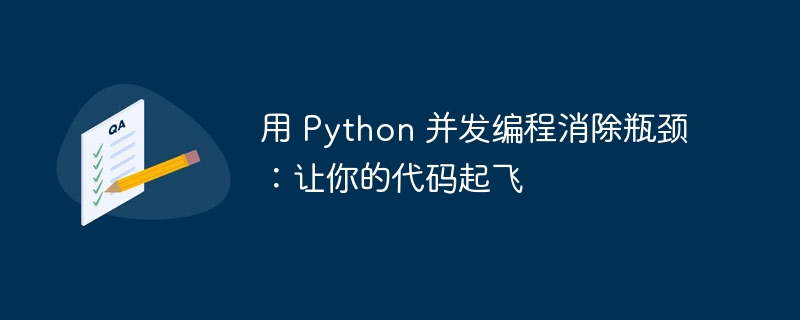Home >Backend Development >Python Tutorial >Eliminate bottlenecks with Python concurrent programming: let your code take off
Eliminate bottlenecks with Python concurrent programming: let your code take off
- PHPzforward
- 2024-02-19 22:18:25712browse

python's Concurrency feature provides a variety of technologies to achieve parallel execution, including multithreading, multitasking processing and asynchronous operations.
Multithreading:
MultipleThreads is a technology that creates multiple threads to perform tasks in parallel. Each thread has its own execution stack, allowing them to run independently. The following code demonstrates how to create and manage threads using the threading module:
import threading
def worker():
print(f"Worker thread {threading.current_thread().name} is running.")
threads = []
for i in range(5):
thread = threading.Thread(target=worker)
threads.append(thread)
thread.start()
for thread in threads:
thread.join()
Multi-tasking:
Multitasking is similar to multithreading, but it uses different operating system level entities (for example, using subprocesses on Unix) to create parallel tasks. Multitasking is less expensive than multithreading, but it does not have access to thread-local storage.
import multiprocessing
def worker(num):
print(f"Worker process {num} is running.")
tasks = []
for i in range(5):
task = multiprocessing.Process(target=worker, args=(i,))
tasks.append(task)
task.start()
for task in tasks:
task.join()
Asynchronous operation:
Asynchronous operations allow tasks to run without blocking the main execution flow. Python’s async<strong class="keylink">io</strong> module provides api that supports asynchronous operations. The following code demonstrates how to use asyncio to create and manage coroutines:
import asyncio
async def worker():
print("Worker coroutine is running.")
async def main():
tasks = [asyncio.create_task(worker()) for _ in range(5)]
await asyncio.gather(*tasks)
asyncio.run(main())
By taking advantage of these concurrency features, you can eliminate CPU and I/O-related bottlenecks in your application. For example, you can parallelize compute-intensive tasks by using multithreading or multitasking, or use asynchronous operations to avoid delays caused by blocking network requests or file I/O. In addition,
Concurrent programmingcan improve the throughput and response time of the application. By creating parallel tasks, applications can handle more requests while providing faster responses to users. This is critical in applications that process real-time data, streaming media, or require high performance. There are some things to consider when using the concurrency feature. Parallel tasks may have data races and deadlock issues, so they must be designed and implemented carefully. Additionally, debugging concurrent programs can be more complex than sequential programs.
In summary, Python's concurrency features provide effective tools for eliminating bottlenecks and improving application performance. By understanding and applying these technologies, developers can create efficient, scalable, and responsive applications.
The above is the detailed content of Eliminate bottlenecks with Python concurrent programming: let your code take off. For more information, please follow other related articles on the PHP Chinese website!

